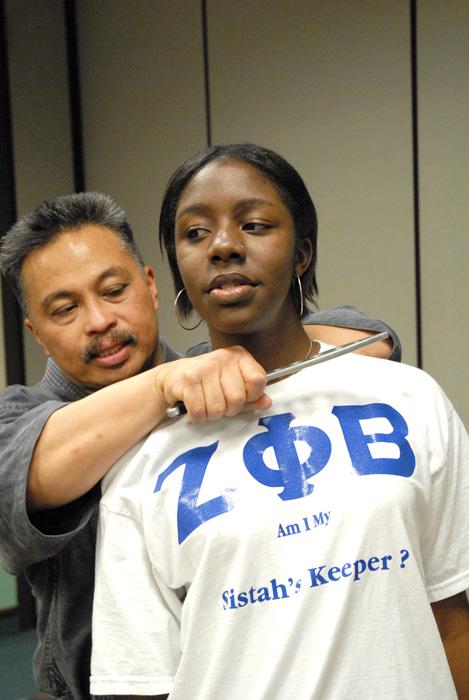Students discuss self defense
Instructor Ed Bansuelo teaches students how to handle knife attack at the Zeta Phi Beta Self Defense Forum on Thursday. Senior social work major Shamanicka Boykins helps demonstrate.:
October 1, 2007
Sacramento State alumna Keisha McGaugh cheered as her friend elbowed a man in the chin and struck his nose with the heel of her hand Thursday night.
“Popoki! Popoki!” McGaugh chanted, miming the cat-like self-defense technique that involves striking an attacker’s face with an open palm then clawing down.
Seven students and alumni gathered into the Auburn Room at the University Union to discuss personal safety, self-defense and learn ways to protect themselves.
Senior social work major Shamanicka Boykins, who participated in several self-defense demonstrations and was cheered on by McGaugh, said students are too lax about safety issues.
“Students feel like they’re automatically safe when they’re on campus, but we’re in the (real) world,” she said. “Anything can happen.”
Senior family consumer science major Edidiong Uwan said campus crime often goes unnoticed.
“You only hear about things if you read the police log,” Uwan said.
Boykins’ assumptions about safety were shattered when she learned one of her sorority sisters was attacked in the past.
“You know that it happens all the time, but it shocks you when it’s someone you know,” she said.
Uwan and Boykins said their sorority, Zeta Phi Beta, decided to host the forum not only to give safety and self-defense knowledge, but also to dispel common gender assumptions.
“Women are shown on TV (as victims), but men get attacked too. People don’t talk about it though,” Boykins said. Three of the seven people who attended the forum were men.
Forum discussions, led by Boykins and Uwan, focused on what constituted self-defense, who needed self-defense knowledge, how gender assumptions formed, personal experiences and what can be done to stay aware and safe.
Participants offered several safety suggestions ranging from walking in the middle of non-busy streets to give oneself more room for evading and escaping an attack to eluding attackers by varying one’s daily route and routine.
Soon after, discussion gave way to demonstration as noises from adjacent meeting rooms were drowned out by the clinking of clashing rattan sticks and cheers from the audience.
Kabaroan associate grandmaster Edward Bansuelo and his protege Brian Long applied techniques from several Filipino martial arts and a Hawaiian martial art to possible attack scenarios.
Boykins and junior business major Jerrad Walls participated in the demonstrations with Bansuelo and Long while most watched.
Uwau said she didn’t want to risk injury.
“I’m more a visual learner anyway,” she said.
Boykins, who learned how to flip an attacker off of her if she was pinned down, said she plans to pass on the maneuvers she learned to her mother and sister.
“I’m not hoping for someone to attack, but now I know what to do,” she said.
Long said even a little knowledge is helpful since most attackers will flee if a potential victim exhibits self-defense capabilities.
“It’s good to know that a simple technique can make the difference between life and death,” Long said.
Periodically diverting his eyes from the demonstrations, sophomore criminal justice major Quentin Saunders said parts of the demonstration — particularly maneuvers directed to the groin area — were a bit too brutal.
“I had to turn away for a lot of it,” Saunders said. “You don’t need to do all that!”
But McGaugh said survival concerns should outweigh an attacker’s well-being.
“It’s better to do too much than too little,” she said.
Marilen Bugarin can be reached at [email protected]





























































































































